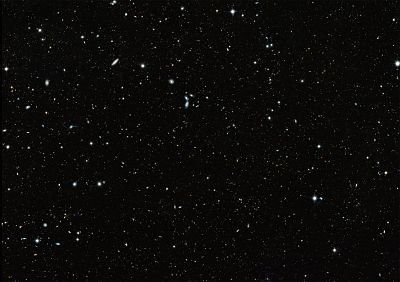The eye-popping image shows more than a quarter of a million galaxies.
Astronomers have created the most detailed picture yet of our evolving universe. The eye-popping image, stitched together from thousands of individual photographs taken by the Hubble Space Telescope, shows more than a quarter of a million galaxies — or about 30 times more galaxies than previous "deep field" photos.
Dubbed the Hubble Legacy Field, the mosaic photo offers not only a detailed look at a tiny patch of sky in the Fornax constellation but also a look back in time.
"The galaxies are scattered across time, from 550 million years ago to 13 billion years ago," Garth Illingworth, an astronomer at the University of California, Santa Cruz, and the leader of the team that created the image, told NBC News MACH in an email. "Their light is just arriving at Earth now, after crossing space for billions of years."
The universe is believed to have come into being as a result of the Big Bang, which occurred an estimated 13.8 billion years ago.
Illingworth called the new image — which shows galaxies so faint and far away that they're 10 billion times too dim for the unaided human eye to see — a "living history book of galaxy development."
Illingworth and his colleagues created the image by combining almost 7,500 separate exposures of roughly 265,000 galaxies taken by Hubble over a 16-year period.
Space
The exposures, taken at a variety of wavelengths in order to highlight particular features of each galaxy, include some from similar photos from Hubble — including the deepest-ever image of the universe, Hubble's eXtreme Deep Field (XDF) from 2012.
Deep-field views help astronomers trace the expansion of the universe, with the galaxies showing when the chemical elements originated and led to the conditions that made life possible.
"The whole succession of Hubble field images has helped clarify, and has clearly emphasized, that the universe is not a place but a process," Ed Krupp, director of the Griffith Observatory in Los Angeles, said. "The Hubble Legacy Field image is just more evidence that the Hubble Space Telescope is one of the best ideas this planet has had," he added.
The new image won't be surpassed until newer space telescopes begin operating, according to NASA. Hubble's long-anticipated successor, the much larger James Webb Space Telescope, is scheduled to be launched in 2021.
Hubble was launched into Earth's orbit in 1990. It was expected to operate for only five to 10 years but has been snapping away for 29 years now — and is expected to keep it up for at least another five years.
WANT MORE STORIES ABOUT SPACE?
- Jeff Bezos unveils Blue Origin's new "Blue Moon" lunar lander
- Scientists finally solve the mystery of weird aurora-like lights in the sky
- Mystery of moon's formation may have been solved
SIGN UP FOR THE MACH NEWSLETTER AND FOLLOW NBC NEWS MACH ON TWITTER, FACEBOOK, AND INSTAGRAM.












